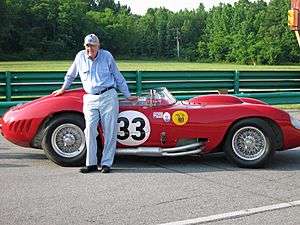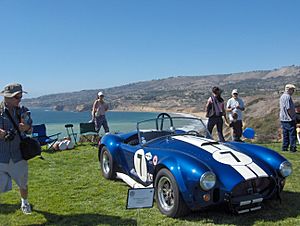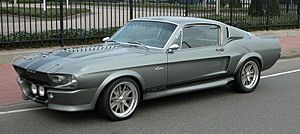Carroll Shelby facts for kids
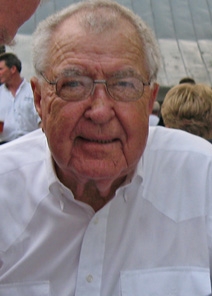
Shelby in 2007
|
|
| Born | Carroll Hall Shelby January 11, 1923 Leesburg, Texas, U.S. |
|---|---|
| Died | May 10, 2012 (aged 89) Dallas, Texas, U.S. |
| Formula One World Championship career | |
| Active years | 1958–1959 |
| Teams | Aston Martin, non-works Maserati |
| Entries | 8 |
| Championships | 0 |
| Wins | 0 |
| Podiums | 0 |
| Career points | 0 |
| Pole positions | 0 |
| Fastest laps | 0 |
| First entry | 1958 French Grand Prix |
| Last entry | 1959 Italian Grand Prix |
| 24 Hours of Le Mans career | |
| Years | 1958–1959 |
| Teams | David Brown Racing Dept |
| Best finish | 1st (1959) |
| Class wins | 1 |
Carroll Hall Shelby (born January 11, 1923 – died May 10, 2012) was an amazing American car designer, race car driver, and businessman. He is most famous for his work with the AC Cobra and Mustang cars for Ford Motor Company. He made these cars much faster and cooler in the 1960s and early 2000s.
In 1962, he started his own company, Shelby American, to build and sell high-performance cars. Carroll Shelby also wrote a book about his life called The Carroll Shelby Story in 1967. One of his biggest achievements as a race car driver was winning the famous 1959 24 Hours of Le Mans race with a teammate.
Contents
Early Life and First Jobs
Carroll Shelby was born in Leesburg, Texas, on January 11, 1923. His father was a mail carrier. From a young age, Carroll had heart problems, which he dealt with his whole life. But even with health issues, he loved speed! He was fascinated by cars and airplanes.
When he was seven, his family moved to Dallas, Texas. Around age 10, he would ride his bike to dirt tracks to watch car races. By 15, he was already driving and taking care of his dad's Ford.
In November 1941, Carroll started learning to fly in the military. After the war, he tried different jobs. He had a dump truck business and even worked on oil wells. For a while, he was a chicken farmer before he decided to focus on cars.
Becoming a Race Car Driver
Carroll Shelby started racing cars professionally when he was 29 years old. He began as an amateur, racing his friend's MG TC car in 1952. He quickly started winning races, even though he only took home trophies, not money.
In 1954, he met John Wyer, who managed the Aston Martin racing team. Wyer asked Shelby to drive for Aston Martin. Shelby traveled to Europe and raced in big events like the 24 Hours of Le Mans and the Thousand Kilometers at Monza. He even helped set about 70 new speed records at the Bonneville Salt Flats in an Austin-Healey car.
Carroll had a serious crash in 1954, but he didn't give up. He kept racing and winning. In 1956 and 1957, Sports Illustrated magazine named him their driver of the year!
In 1959, he achieved one of his biggest dreams: winning the 1959 24 Hours of Le Mans race. He shared the victory with his teammate, Roy Salvadori, driving an Aston Martin DBR1. Shelby later said winning Le Mans was "probably the greatest thrill I ever got out of racing."
After his racing career, in 1961, Carroll Shelby opened a special school. It was called the Shelby School of High Performance Driving, where he taught others how to drive fast and well.
Building Amazing Cars
Carroll Shelby realized that America needed a special kind of sports car. A car you could drive every day but also race on the weekends. His idea was to put a powerful V8 engine into a lightweight car.
In 1960, Carroll stopped racing due to health reasons. He then started his company, Shelby-American, in Los Angeles. He found a car chassis (the frame of a car) from a company called AC. He also got powerful V8 engines from Ford Motor Company. He put them together to create a brand new car!
This new car was first called the Carroll Shelby Experimental, then the Shelby AC Cobra, and finally, the AC Cobra. Production started in 1962, and people loved them!
Shelby also worked with Ford on their GT40 racing program. Ford wanted to win the Le Mans race, and Shelby helped them make the GT40 super fast and reliable. In 1966, the GT40 Mark II, designed with Shelby's help, won the Le Mans race with a famous 1-2-3 finish for Ford!
He also worked with Ford to create special versions of the Ford Mustang. These cars were called the Shelby GT350 (starting in 1965) and the Shelby GT500 (starting in 1967). These Mustangs were known for their amazing performance.
After working with Ford, Shelby also helped other big car companies. He worked with Dodge (part of Chrysler) and Oldsmobile (part of General Motors) to make their cars perform better.
Shelby Series 1
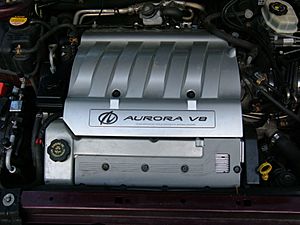
The Shelby Series 1 is very special because it's the only car Carroll Shelby designed completely from scratch. All his other famous cars were based on models from other companies that he then modified.
The Series 1 was a powerful sports car. It had a special Oldsmobile V8 engine. Only 249 of these cars were built in 1999. They were very fast, going from 0 to 60 mph in just 4.1 seconds for the supercharged version! They also had modern features like power steering, air conditioning, and power windows.
Modern Ford-Shelby Cars

In 2003, Carroll Shelby started working with Ford Motor Company again. He became a technical advisor for the Ford GT project.
Ford and Shelby also showed off some cool concept cars, like the Ford Shelby Cobra Concept and the Ford Shelby GR-1. These were amazing designs that looked like modern versions of his classic cars, but they were never mass-produced.
However, a new Shelby GT500 was released in 2006. It was a super powerful Mustang with a 5.4-liter V8 engine and a supercharger, making it incredibly fast. Carroll Shelby gave Ford ideas to make this car even better, like using wider rear tires.
Shelby also teamed up with Hertz Corporation to create special "Shelby GT-H" Mustangs. These cars were available for rent, just like a famous "Rent-a-Racer" program from 1966. A consumer version, the Shelby GT, was also sold through Ford dealers.
Other Cool Projects
Carroll Shelby also worked on other car projects. In the 1960s, he helped the Rootes Group (who made Sunbeam cars) put a powerful Ford V8 engine into their Sunbeam Alpine sports car. This new car was called the Sunbeam Tiger.
He also licensed his name to many products outside of cars. His company, Carroll Shelby Licensing, makes sure his name and famous car designs are used correctly.
In 2008, Carroll Shelby received the Automotive Executive of the Year Award, which is a big honor in the car world.
Helping Others
Carroll Shelby cared about helping people. He started the Carroll Shelby Children's Foundation. This foundation helps pay for medical treatments for children who have heart disease and can't afford the care they need.
He also partnered with Northeast Texas Community College to support their automotive program. He gave money for scholarships to help students who want to learn about car technology. The program was even renamed the Carroll Shelby Automotive Program.
His Story in a Book
Carroll Shelby wrote his own story in a book called The Carroll Shelby Story. It was first published in 1967. The book talks about his exciting days as a race car driver, all the challenges he faced, his big wins, and even his crashes. It also explains how he came up with the idea for his amazing Shelby Cobra car.
Personal Life and Health
Carroll Shelby was married seven times. He had three children with his first wife, Jeanne Fields: Sharon Anne, Michael Hall, and Patrick Bert.
Carroll Shelby faced many health challenges throughout his life. He received a heart transplant in 1990 and a kidney transplant in 1996. He passed away on May 10, 2012, at the age of 89, after battling heart problems for many years.
Images for kids
See also
 In Spanish: Carroll Shelby para niños
In Spanish: Carroll Shelby para niños
- The Snake and the Stallion


